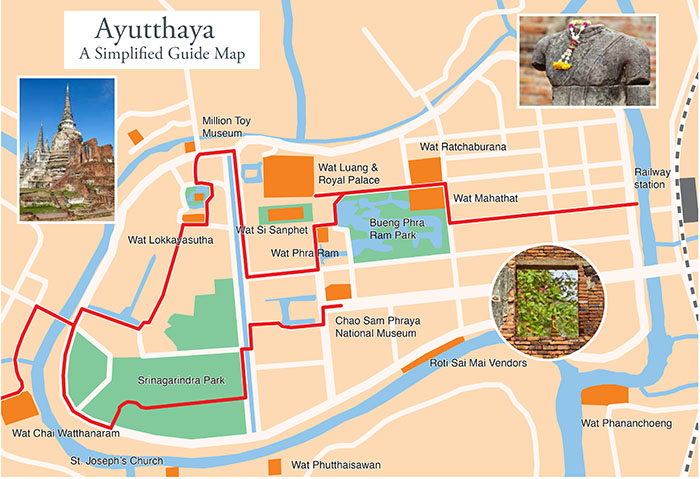Ayutthaya, the ancient capital of Siam
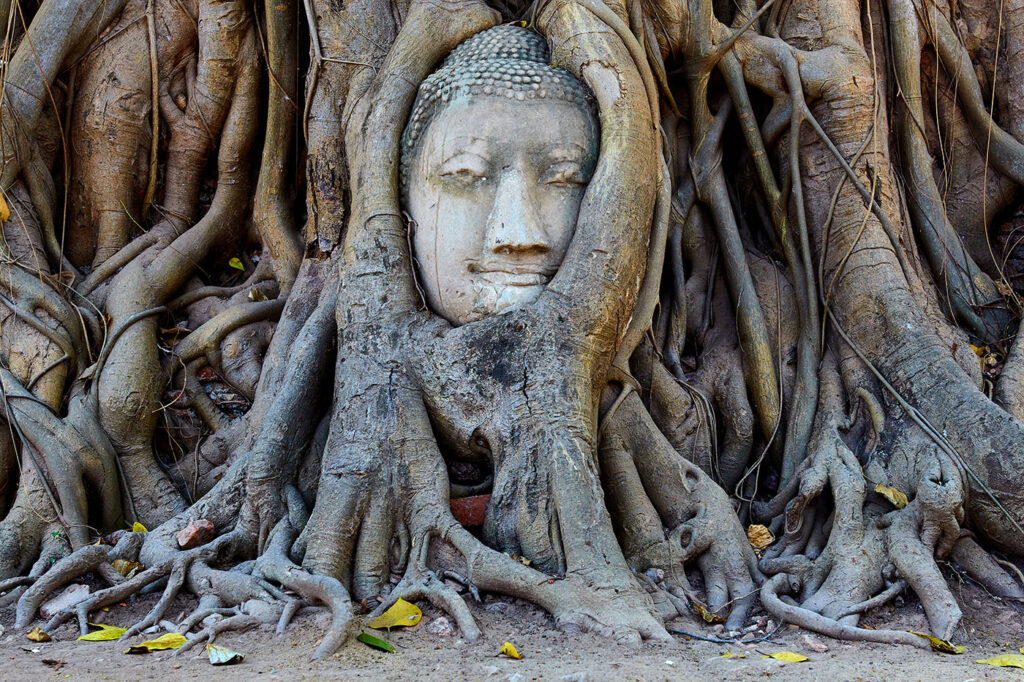
Ayutthaya, the ancient capital of Siam
At its peak, Ayutthaya was said to be one of the most magnificent cities in Asia. An éntrepot of trade, a centre for literature, the dramatic arts and architecture as well as boasting a vibrant social life. It would have been a spectacular sight with its towers and the spires of innumerable chedis glittering in the sunshine. Orange-robed monks commuting between monasteries and perhaps the occasional dignitary atop an elephant. Elsewhere would be the simple wooden dwellings of the common folk, tidy lanes where chickens forage and barefoot children play.
Then in April 1767, after a 14-month siege, the Burmese armies sacked it. What they couldn’t loot they smashed, and burned what was left of the city to the ground. Many residents fled south but over 30.000 were taken prisoner.
The occupation lasted less than a year. The Burmese were expelled by General Taksin in November 1767 but the city never recovered. The capital was moved south to Thon Buri and eventually across the river to present-day Bangkok. Today Ayutthaya is a small provincial town existing amidst the ruins of its former glory.
It was founded in 1350 by Prince U-Thong after he had led a successful campaign against Sukhothai and on the 4th of March 1351, he ascended the throne as King Ramathibodi I.
Getting about
If you start early visiting the main sites in Ayutthaya is an easy day trip from Bangkok. Busses or vans can be found at Mo Chit and trains from Bang Sue Grand Station whose official name is Krung Thep Aphiwat Central Terminal.
It is quite possible to book tours in advance and it is also easy to find a tuk-tuk who will be happy to drive you around for the day after you arrive. For the more independent-minded, bicycles and motorbikes are available for rent. But before you do, it is worth thinking about the places you wish to visit in advance. The railway station is not on the island and the only way onto it by road is across the all too frequently traffic-choked Pridi Thamrong Bridge and Thai traffic is not for the faint-hearted.
There is a less coronary-inducing alternative. Directly opposite the station is a small road that leads down to a pier. Here you will find a little boat that, for a few baht, ferries passengers backward and forwards across the river. After disembarking there are more bike rental places.
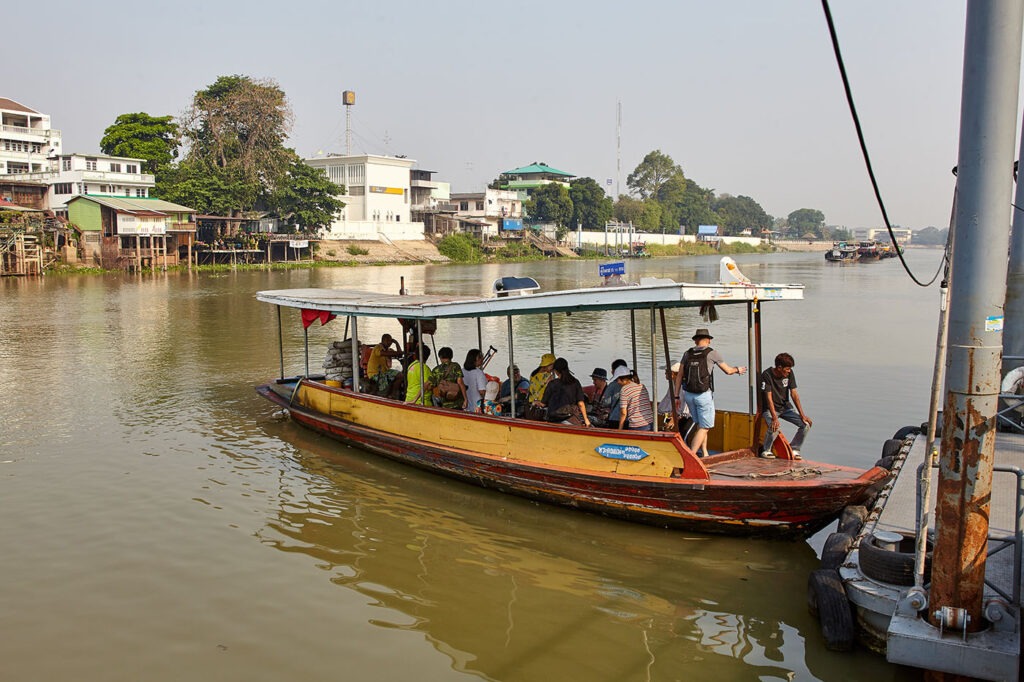
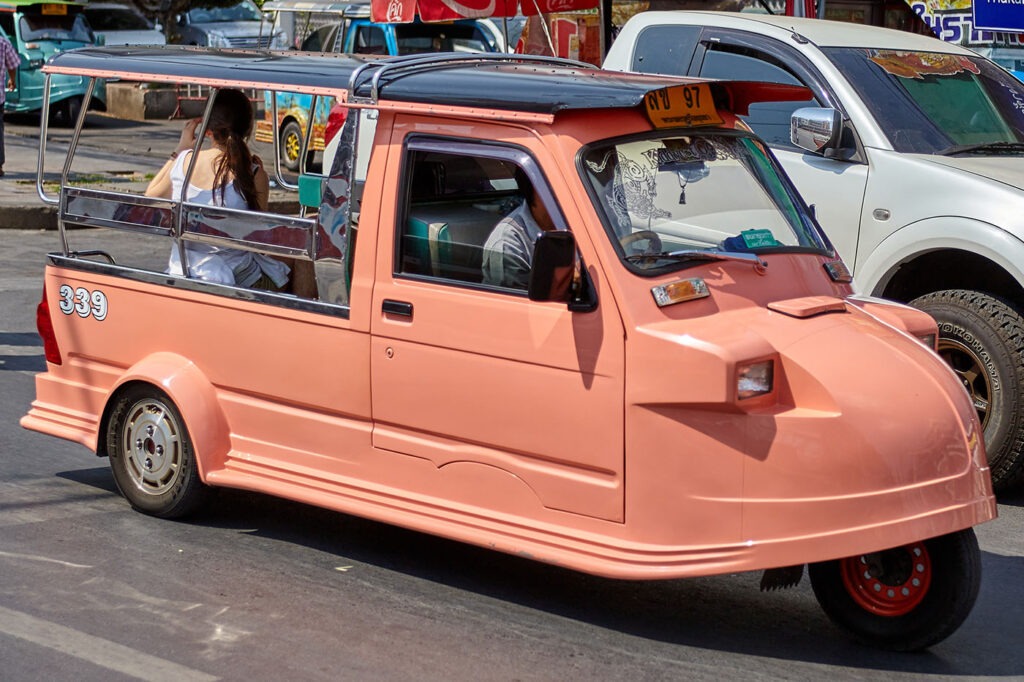
The ferry across the Pa Sak River and an Ayutthaya style tuk tuk
After the bridge, the traffic dissipates a little. U-Thong Road circumnavigates the island but most of the more interesting ruins can be reached via the considerably quieter side roads. There is way more than can reasonably be taken in on a single day but unless you are a dedicated historian the main sites are probably enough.
Wat Mahathat and Wat Ratchaburana
After disembarking from the ferry and selecting your wheels, head up the street until you meet U-Thong Road. Cross over and continue along the side road, called Ho Rattanachai Road, which is almost directly opposite. Then cross the intersection at Khlong Makharm Riang Road. After a little more than a kilometre you will come to the end of the road. Turn right here and you will find yourself at Wat Mahathat.
This is one of the most important sites historically as well as being one of the most popular. The sandstone head of a Buddha statue entwined within the roots of a bodhi tree (Ficus religiosa) makes it one of the most photographed Instagram locations in the whole city (main picture).
Wat Mahathat means Temple of the Great Relic. It was a royal monastery located close to the Grand Palace. Construction began in 1374, during the reign of King Borommaracha I though completion was not until sometime after 1388 during King Ramesuan’s reign.
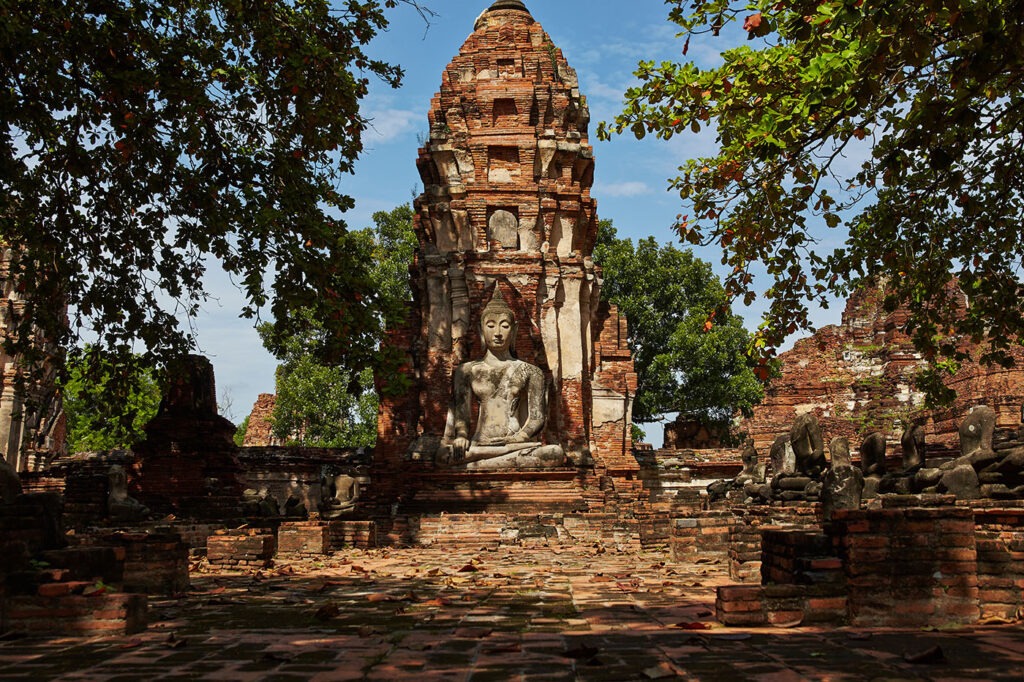
Buddha image in front of the viharn at Wat Mahathat
The main elements consisted of a central Khmer style prang, which stood at 38 metres tall and topped with a six-metre finial, surrounded by four smaller prangs. These were enclosed in a courtyard and gallery lined with Buddha images. The central prang collapsed in 1632 but was restored a year later with its height being raised to 44 metres which, with finial added, brought the total height up to 50 metres. During excavations in 1956, numerous relics and gold artefacts were found beneath the main tower. These are now on display at the Chao Sam Phraya Museum.
Wat Ratchaburana is another royal temple located directly across Naresuan Road from Wat Mahathat and built in the same Khmer style. The entrance is particularly impressive. As one climbs the steps to the viharn, the main prang is framed by the doorway.
Following the death of King Intharacha, who reigned from 1409 to 1424, two of his three sons, Chao Ai Phraya and Chao Yi Phraya, engaged in combat to claim the throne. They were both killed in the fight so the third son, Chao Sam Phraya was invited to ascend the throne as King Borommaracha II.
Read also: Sukhothai, the cradle of Thai civilisation Read also: Historic towns of the Sukhothai Kingdom
Construction began in 1424 on the site where the two brothers did battle and the new king commanded that two chedis should be built to commemorate them. The two chedis are in the southwest of the compound.
Bueng Phra Ram Park is directly behind Wat Mahathat it is a pleasant grassy area with pretty ponds and bridges as well as a few minor ruins. The Prasat Sang, however, which sits in the middle of the park, is not ancient at all. It was built in 1970 as a residence for the spirit of King Ramathibodi I.
Continuing along Naresuan Road it veers to the left around the western end of the park and then turns right. Up ahead you will see the front of Wihan Phra Mongkhon Bophit. This contains a bronze, 17 metre tall seated Buddha that was made in 1538. It was originally enshrined to the east of the Grand Palace but King Songtham, who reigned from 1610 to 1628, ordered the image moved to the west and had a square roofed structure called a mondop built over it. Around 1700 the mondop was struck by lightning so the king ordered a new viharn to be built around it.
The image was badly damaged again during the fall of Ayutthaya in 1767. It was repaired again in 1920. Further restorations took place in 1931 and 1955. The viharn was rebuilt in 1957 with a donation from the prime Minister of Burma.
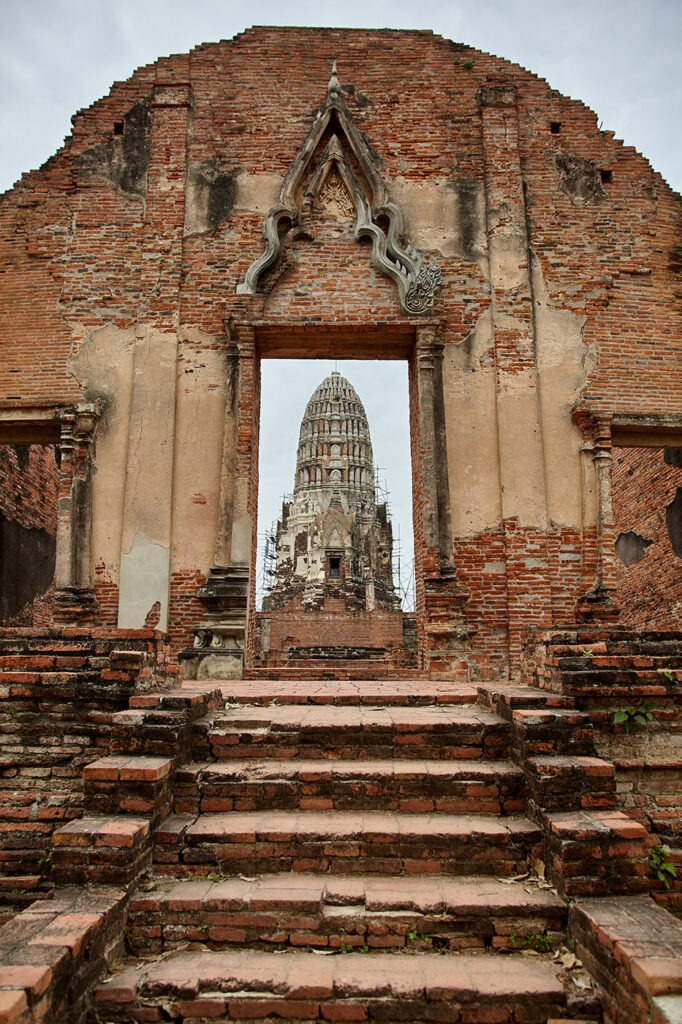
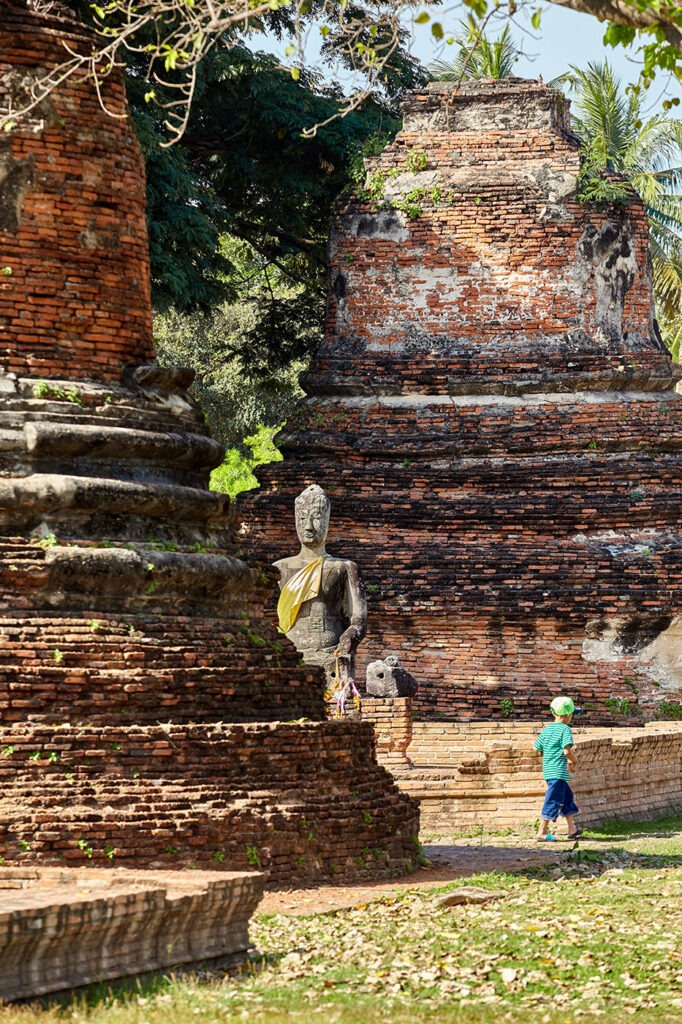
Wat Ratchaburana (above left). Wat Phra Si Sanphet (right and below)
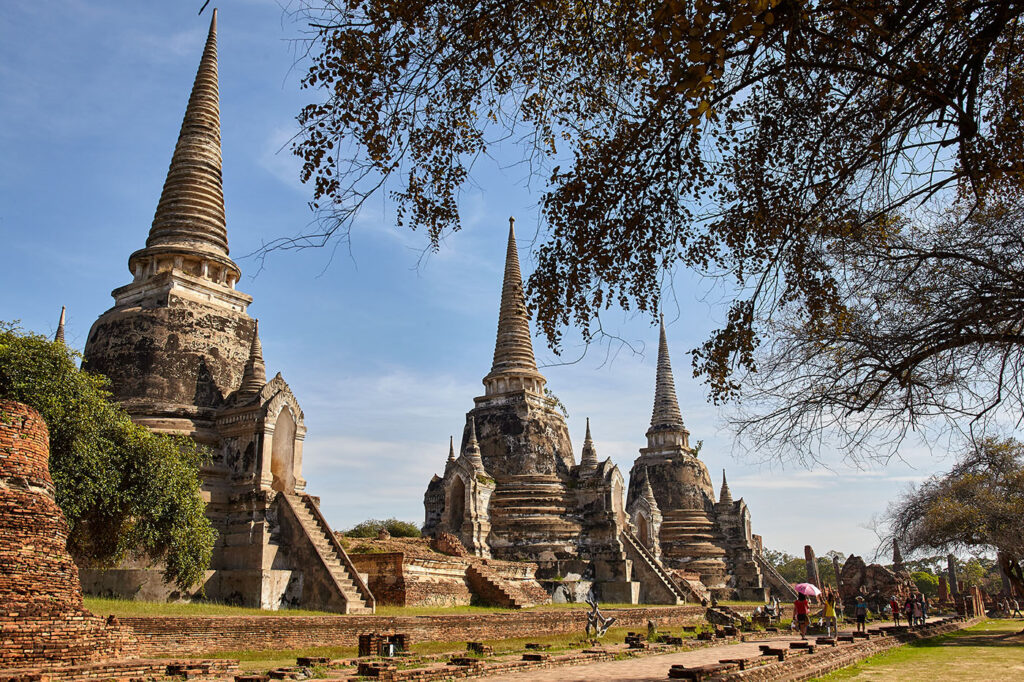
Wat Phra Si Sanphet and Wat Phra Ram
Built on the site of the original royal palace Wat Phra Si Sanphet was the holiest temple in the whole of Ayutthaya. The name means Temple of the Holy, Splendid Omniscient. In 1448 a new palace was built to the north and King Borommatrailokkanat, who reigned from 1431 to 1488, designated the grounds of the old, a holy site. In 1492, two chedis were added by his son, King Ramathibodi II to house the ashes of his father and his brother, King Borommaracha III.
A hall of worship, called Viharn Luang (Royal Chapel) was added in 1499 and King Ramathibodi II commissioned a 16-metre high standing Buddha to be cast in bronze and covered from head to toe in gold. The image was called Phra Si Sanphetdayan from which the temple takes its name. The third chedi was added in 1529 by King Borommaracha IV to enshrine the ashes of his father, King Ramathibodi II. After the Burmese invasion of 1767, only the three Chedis were left standing.
Wat Phra Ram stands a little to the southwest of Wat Phra Si Sanphet. No one knows the exact date of construction but it is believed to have been somewhere between the death of King Ramathibodi I in 1369 and the death of Borommaracha II in 1424. It follows the same Khmer architectural styles as Wat Mahathat and Wat Ratchaburana.
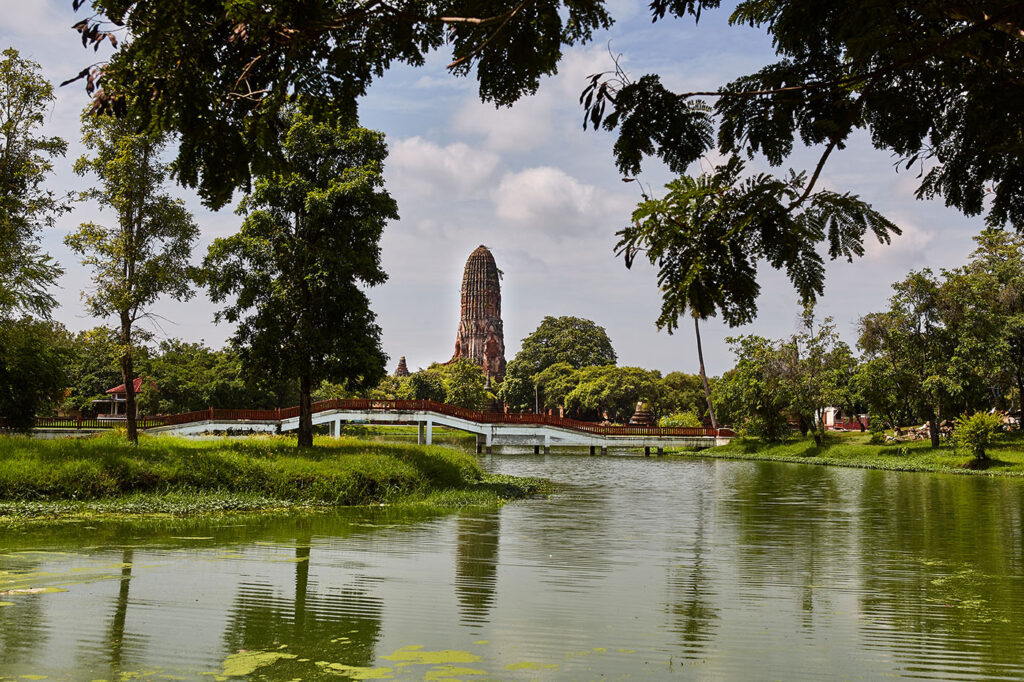
The prang of Wat Phra Ram seen from across Bueng Phra Ram Park
Due west of Wat Phra Ram on the Klong Tho Road there is a little market area which is a part of Wihan Phra Mongkhon Bophit. It is an interesting place selling preserved fruits and souvenirs though aimed primarily at local tourists,
Taking a short break from ancient ruins the next stop should be the Million Toy Museum. Continue north along Klong Tho Road turning left at the end into U-Thong Road. Follow this for about 220 metres until you see the blue signs for the museum. The entrance is on U-Thong although the signs seem to hint that you might want to turn right.
The museum is the brainchild of Krirk Yoonpun, a lecturer in the Children’s Literature Department at Srinakharinwirot University. He began his toy collection after a 1982 visit to the Kitahara Tin Toy Museum in Yokohama, Japan.
The Million Toy Museum opened in 2008 and is housed in a bright pastel blue and white building. It consists of hundreds of old tin plate as well as plastic toys, life-size figures of Yoda and other superheroes, vintage ceramic ornaments and many other objects of daily life. There is also a small cafe where a life-sized statue of Jar Jar Binks will quietly oversee your refreshments.
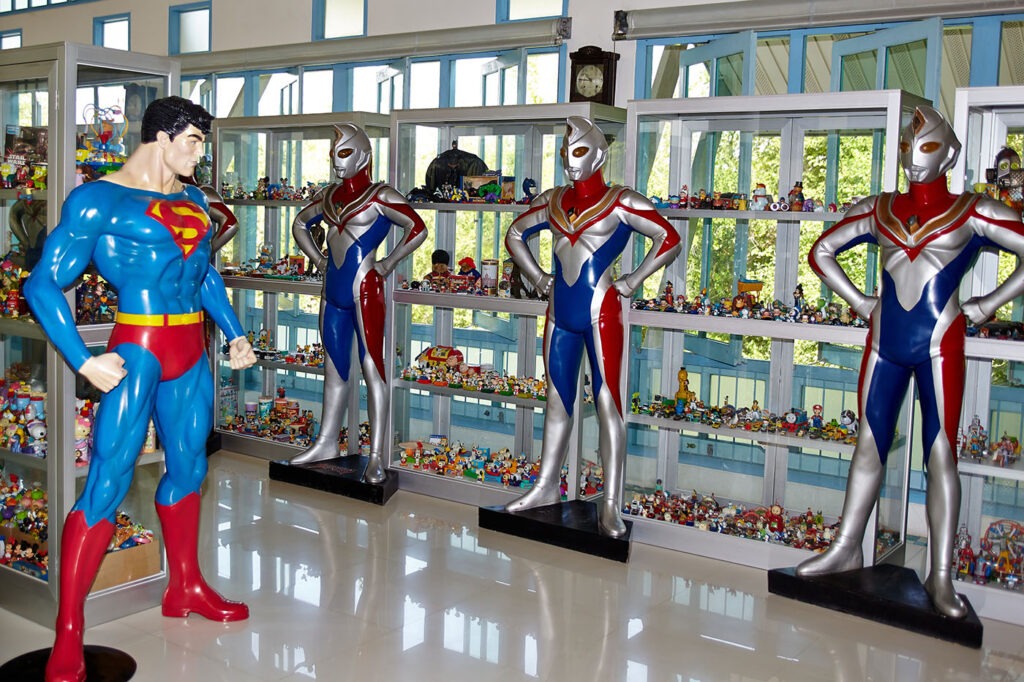
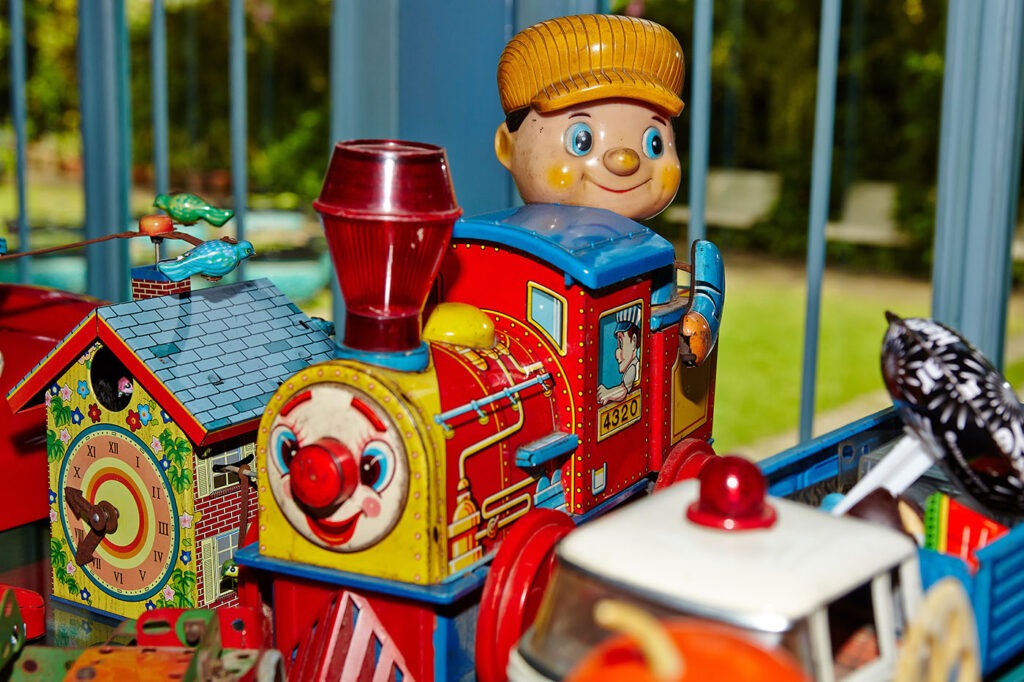
Superman, Ultra man and old tin-plate toys at the Million Toy Museum. The reclining Buddha at Wat Lokkayasutha (below)
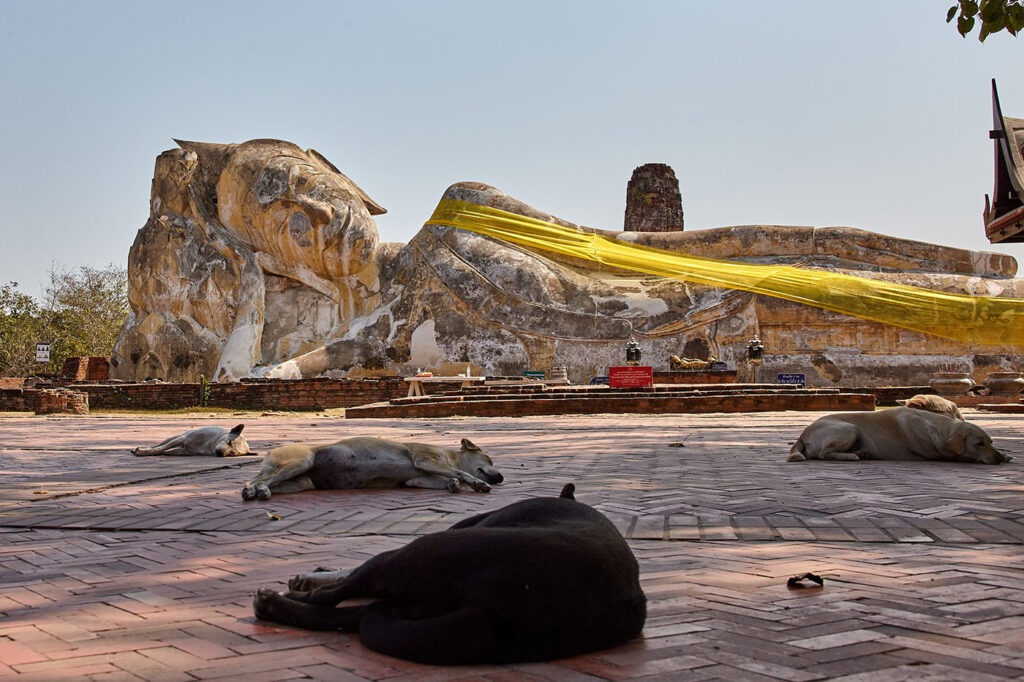
Directly opposite is a small, rather uninteresting looking road but it is worth following. After about 200 metres the road divides. A left turn will take you past Wat Worachettharam which was founded in 1593. All that is left is a large chedi with a Buddha image in front and the walls of the viharn, both of which can be seen from the road. It is believed the ashes of King Naresuan are interred here.
A little further along the road swings to the right and passes around Wat Lokkayasutha. At the other end is an impressive reclining Buddha which clocks in at 42 metres long with a height of eight meters. It is named Phra Buddha Sai Yat and was once enclosed within a viharn. The date of construction is not known but the style is mid-Ayutthaya period.
Take a left turn at the intersection here and follow the leafy residential lane for 750 metres. Just before that, there is a right turn past a small supermarket then a left slip road which will take you on to U-Thong Soi 26 which will lead eventually to a left turn into U-Thong Road.
Wat Chaiwatthanaram
The roads at this end of the island are not as frantic and a right turn across the bridge followed by a left will lead to Wat Chaiwatthanaram. The temple, which can be seen from the bridge, sits on the banks of the Chao Phraya River and would have originally been accessed by boat or barge.
The main prang is 35 metres tall and surrounded by four smaller prangs on a central platform symbolising Mt Meru, the centre of Buddhist cosmology. Surrounding this is a gallery lined with 120 Buddha images. The gallery is punctuated with eight funeral towers at each of its corners and midway along each side.
It was commissioned in 1630 by King Prasat Thong, who reigned from 1629 to 1656, to honour his foster mother whose ashes, it is thought, are interred here. Since its construction, all of Ayutthaya’s Kings made pilgrimages here to attend royal funerals.
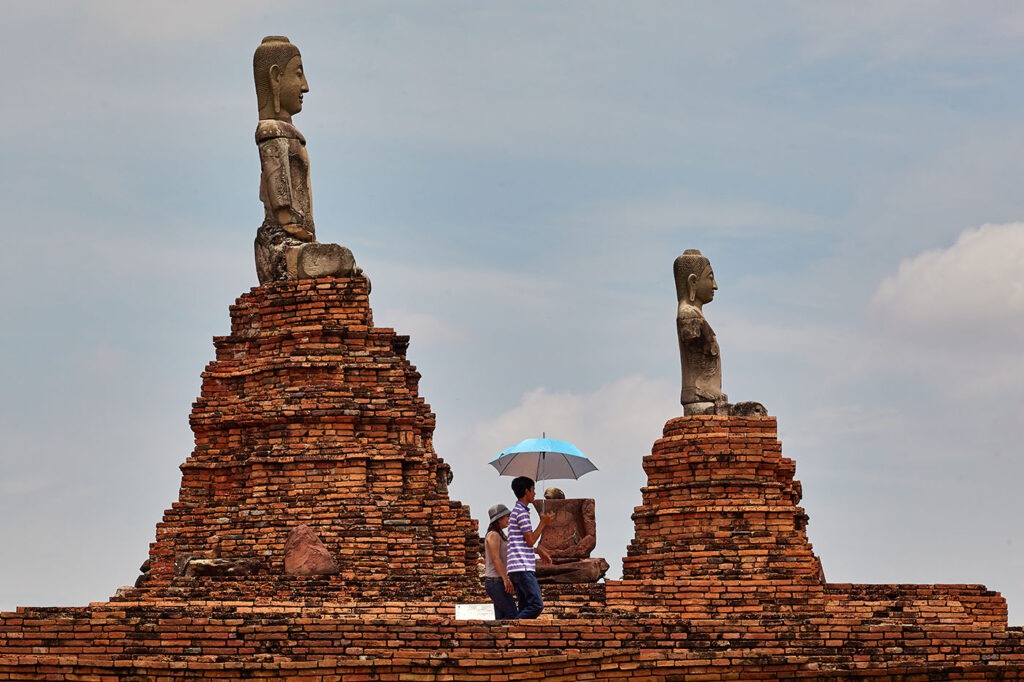
Wat Chaiwatthanaram (above and below left). Roti sai mai, a sweet treat to end the day (below right)
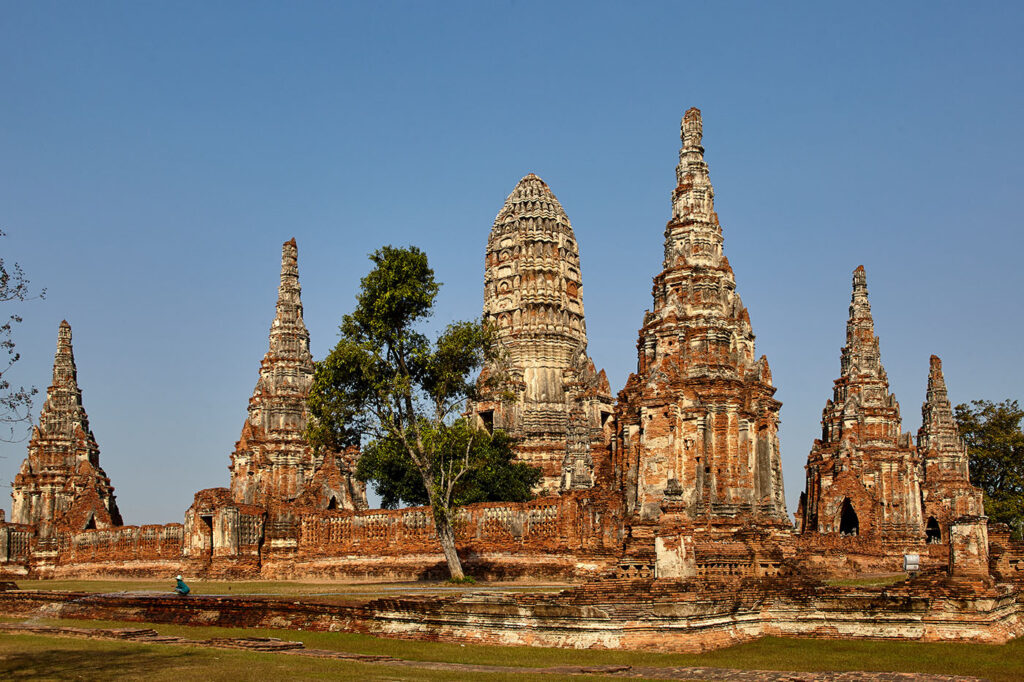

One last port of call is the Chao Sam Phraya National Museum. This was opened in 1961 specifically to house the treasures that were recovered from Wat Mahathat and Wat Ratchaburana but over the years more has been added. The collection includes relics, statues, jewellery, ceramics, wooden artefacts and other artworks.
For those with a love of history, there is still much more to see, but much more time is also needed. If you are heading back to your starting point the southern side of U-Thong road is not so busy. Look out for a local treat called roti sai mai, a pandan or sweet potato-flavoured crepe wrapped around a sugary candy floss or cotton candy-like filling.
For those that wish to stay a little longer here are some places to stay:Centara AyutthayaSala Ayutthaya
